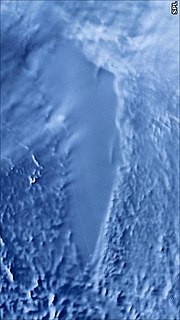Related Research Articles

Lake Vostok is the largest of Antarctica's almost 400 known subglacial lakes. Lake Vostok is located at the southern Pole of Cold, beneath Russia's Vostok Station under the surface of the central East Antarctic Ice Sheet, which is at 3,488 m (11,444 ft) above mean sea level. The surface of this fresh water lake is approximately 4,000 m (13,100 ft) under the surface of the ice, which places it at approximately 500 m (1,600 ft) below sea level.

A subglacial lake is a lake that is found under a glacier, typically beneath an ice cap or ice sheet. Subglacial lakes form at the boundary between ice and the underlying bedrock, where gravitational pressure decreases the pressure melting point of ice. Over time, the overlying ice gradually melts at a rate of a few millimeters per year. Meltwater flows from regions of high to low hydraulic pressure under the ice and pools, creating a body of liquid water that can be isolated from the external environment for millions of years.
Neptunomonas antarctica is a species of bacteria. It is Gram-negative, motile, facultatively aerobic and oxidase- and catalase-positive. The type strain is S3-22T.
Nocardioides antarcticus is a gram-positive, aerobic, rod-shaped and non-motile bacterium from the genus Nocardioides that has been isolated from marine sediments from Ardley Cove near King George Island in Antarctica.
Roseomonas is a genus of Gram negative bacteria. The cells are coccoid rods when viewed microscopically. Certain species are known to be opportunistic infections for humans.
Cognatiyoonia sediminum is a Gram-negative, strictly aerobic and short rod-shaped bacterium from the genus of Cognatiyoonia which has been isolated from marine sediments from the northern Okinawa Trough in China.
Roseicitreum is a Gram-negative, aerobic and non-motile genus of bacteria from the family of Rhodobacteraceae with one known species. Roseicitreum antarcticum has been isolated from sediments from the Zhongshan Station from the Antarctica.

Mercer Subglacial Lake is a subglacial lake in Antarctica covered by a sheet of ice 1,067 m (3,501 ft) thick; the water below is hydraulically active, with water replacement times on the order of a decade from the Ross Sea.
Aurantimonas aggregata is a Gram-negative, short-rod-shaped and aerobic bacteria from the genus of Aurantimonas which has been isolated from deep-sea sediments from the Ross Sea in the Antarctica.
Arenibacter catalasegens is a Gram-negative, aerobic, rod-shaped and non-motile bacterium from the genus of Arenibacter which has been isolated from surface sediments from the Southern Indian Ocean.
Gramella aestuariivivens is a Gram-negative, aerobic and non-spore-forming bacterium from the genus of Gramella which has been isolated from tidal flat sediments from the South Sea in Korea.
Gramella aquimixticola is a Gram-negative, non-spore-forming aerobic and motile bacterium from the genus of Gramella which has been isolated from estuary water from Hwajinpo in Korea.
Gramella bathymodioli is a Gram-negative, rod-shaped, strictly aerobic and motile bacterium from the genus of Gramella which has been isolated from a mussel from the Tangyin hydrothermal field.
Gramella forsetii is a Gram-negative, strictly aerobic, chemoorganotrophic and heterotrophic bacterium from the genus of Gramella which has been isolated from water from roads from Helgoland near the North Sea.
Gramella fulva is a Gram-negative, aerobic and motile bacterium from the genus of Gramella.
Gramella gaetbulicola is a Gram-negative, aerobic and rod-shaped bacterium from the genus of Gramella which has been isolated from foreshore soil.
Gramella lutea is a Gram-negative, aerobic, rod-shaped and non-motile bacterium from the genus of Gramella which has been isolated from marine sediments from Hwangwooji from the Jeju island.
Gramella oceani is a Gram-negative, strictly aerobic, non-endospore-forming and rod-shaped bacterium from the genus of Gramella which has been isolated from marine sediments from the coast from Kending in Taiwan. Gramella oceani produces zeaxanthin.
Gramella portivictoriae is a Gram-negative, strictly aerobic and rod-shaped bacterium from the genus of Gramella which has been isolated from marine sediments.
Gramella salexigens is a Gram-negative, aerobic and non-spore-forming bacterium from the genus of Gramella which has been isolated from water from Hwajinpo in Korea.
References
- 1 2 "Species: Gramella antarctica". LPSN.DSMZ.de.
- 1 2 Li, An-zhang; Han, Xi-bin; Lin, Long-zhen; Zhang, Ming-xia; Zhu, Hong-hui (1 January 2018). "Gramella antarctica sp. nov., isolated from marine surface sediment". International Journal of Systematic and Evolutionary Microbiology. 68 (1): 358–363. doi: 10.1099/ijsem.0.002513 . PMID 29205131.
- ↑ "www.uniprot.org".Cite journal requires
|journal=(help)
| This Flavobacteria-related article is a stub. You can help Wikipedia by expanding it. |